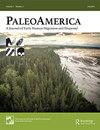Topper Site Revisited: Exploring Spatial Organization of Clovis Life at the Quarry
IF 1.7
Q1 ANTHROPOLOGY
引用次数: 0
Abstract
ABSTRACTTopper is one of the largest buried Clovis sites in North America. The decades of archaeological excavations and analyses of Topper assemblages have informed our understanding of Clovis technology, mobility, settlement, and, more recently, chronology in the American Southeast. In this paper, we use spatial analysis to explore intra-site variation at Topper. We find that distance and elevation from the outcrop influenced the organization of core and biface reduction to some degree, as workshop areas were positioned close to the source. Other areas, closer to domestic spaces, were also provisioned with cores. Analysis of the Alluvial Terrace yielded evidence of spatially segregated campsite activities. The scale of excavation and the extent of the site vicinity – covering 629 m2 and spanning multiple topographic features – offer an unprecedented opportunity to investigate the spatial organization of Clovis life at the quarry.KEYWORDS: ClovisAmerican Southeastquarryspatial analysislithic technology AcknowledgementsWe have great appreciation for the hard-working volunteers who spent many summers with us at Topper: Alison and John Simpson, Darrell Barnes, Bill Covington, Ernest Plummer, DuVal Lawrence, Wes Muckenfuss, Tom and Betsy Pertierra, Bill Lyles, Carol Reed, Jean Guilleux, Judith Scruggs, Leslie Page, Paula Zitzelberger, Steve Williams, Judy Kendall, Leon Perry, Charles Terry, Lynne Nasi, Martha Christy, Neal Konstantin, Tom Cofer, Terry Hynes, Connie White, Erik Shofner, Henry Wilkinson, Rooney Floyd, Lori Smith, Lorene Fisher, Neill Wilkinson, Pat McGinnis, Bob Cole, Cynthia Curry, Elizabeth Allan, Hal Curry, Anita Lehew, Don and April Gordon, and Ann Judd. Thank you for the years of dedication, support, and friendship. We also thank Clariant Corp for their many accommodations from 1996–2013.Disclosure statementNo potential conflict of interest was reported by the author(s).Additional informationNotes on contributorsAshley M. SmallwoodAshley M. Smallwood (PhD Texas A&M University 2011) is an Associate Professor of Anthropology at the University of Louisville. Her research interests include the Paleoindian and Early Archaic records of the American Southeast, hunter-gatherer adaptations, and stone artifact analysis.Albert C. GoodyearAlbert C. Goodyear, III (PhD Arizona State University 1976) is a Research Affiliate for the South Carolina Institute for Archeology and Anthropology. His research interests include Paleoindian and other early prehistoric time periods, the Pleistocene-Holocene transition, lithic technology, and geoarchaeology with a special focus on soil science applications.D. Shane MillerD. Shane Miller (PhD Arizona 2014) is an Associate Professor in the Department of Anthropology and Middle Eastern Cultures at Mississippi State University and archaeologist whose main interests are the Ice Age colonization of the Americas and the origins of agriculture in eastern North America.Joan PlummerJoan Plummer is a volunteer and database manager for the Southeastern Paleoamerican Survey and the Topper site, Martin, South Carolina.Douglas A. SainDouglas A. Sain (PhD University of Tennessee 2015) is a Senior Archeologist for Terracon. His research interests include the prehistoric colonization of the Americas, lithic technology, and the use of spatial data for the development of models to better understand past human behavior. His region of interest is the southeast and Mid-Atlantic United States.Derek T. AndersonDerek T. Anderson is an archaeologist and the outreach coordinator at the Cobb Institute of Archaeology at Mississippi State University. His research interests focus on Late Pleistocene faunal and lithic resource use in North America.Thomas A. JenningsThomas A. Jennings (PhD Texas A&M University 2012) is an Associate Professor of Anthropology and the Director for the Center for Archaeology and Cultural Heritage at the University of Louisville. His research interests include the peopling of North America, hunter-gatherers, geoarchaeology, lithic technologies, Quaternary environments, curation, and public archaeology.重访托普遗址:探索采石场克洛维斯生命的空间组织
托普是北美最大的克洛维遗址之一。几十年的考古发掘和对托普尔组合的分析,使我们了解了克洛维人的技术、流动性、定居,以及最近在美国东南部的年代学。在本文中,我们使用空间分析来探讨托普尔的站点内变化。研究发现,与露头的距离和海拔在一定程度上影响了岩心的组织和双面还原,因为工厂区位于离震源较近的地方。其他更接近家庭空间的区域也配备了核心。对冲积阶地的分析提供了空间隔离露营活动的证据。挖掘规模和场地附近的范围——占地629平方米,跨越多种地形特征——为研究采石场克洛维斯生活的空间组织提供了前所未有的机会。关键词:克洛维斯美国东南部采石场空间分析石器技术感谢我们在托普度过了许多个夏天的辛勤工作的志愿者们:艾莉森和约翰·辛普森、达雷尔·巴恩斯、比尔·卡温顿、欧内斯特·普卢默、杜瓦尔·劳伦斯、韦斯·Muckenfuss、汤姆和贝琪·佩蒂拉、比尔·莱尔斯、卡罗尔·里德、让·吉列、朱迪·斯克鲁格斯、莱斯利·佩奇、葆拉·齐泽尔伯格、史蒂夫·威廉姆斯、朱迪·肯德尔、利昂·佩里、查尔斯·特里、琳恩·纳西、玛莎·克里斯蒂、尼尔·康斯坦丁、汤姆·科弗、特里·海因斯、康妮·怀特、埃里克·肖夫纳、亨利·威尔金森、鲁尼·弗洛伊德、洛里·史密斯、洛琳·费舍尔、尼尔·威尔金森、帕特·麦金尼斯、鲍勃·科尔、辛西娅·库里、伊丽莎白·艾伦,哈尔·库里,安妮塔·勒休,唐·戈登夫妇,还有安·贾德。感谢您多年来的奉献、支持和友谊。我们也感谢科莱恩公司(Clariant Corp .)在1996年至2013年期间提供的许多便利。披露声明作者未报告潜在的利益冲突。作者简介:ashley M. Smallwood(2011年德州农工大学博士)是路易斯维尔大学人类学副教授。她的研究兴趣包括美国东南部的古印第安人和早期古代人的记录,狩猎采集者的适应,以及石器制品的分析。Albert C. Goodyear, III(亚利桑那州立大学1976年博士)是南卡罗来纳考古与人类学研究所的研究员。他的研究兴趣包括古印度和其他早期史前时期,更新世-全新世过渡,石器技术和地质考古学,特别关注土壤科学的应用。Shane时候。特哲·米勒德Shane Miller(2014年亚利桑那州博士)是密西西比州立大学人类学和中东文化系的副教授和考古学家,他的主要兴趣是美洲的冰河时期殖民和北美东部农业的起源。琼·普卢默(Joan Plummer)是东南古美洲调查和南卡罗莱纳马丁托普尔站点的志愿者和数据库管理员。道格拉斯·a·塞恩(2015年田纳西大学博士)是泰拉肯的高级考古学家。他的研究兴趣包括史前美洲殖民,石器技术,以及利用空间数据开发模型以更好地理解过去的人类行为。他感兴趣的地区是美国东南部和大西洋中部。德里克·t·安德森(Derek T. Anderson)是一名考古学家,也是密西西比州立大学科布考古研究所的外联协调员。他的研究兴趣集中在北美晚更新世动物和岩石资源的利用。托马斯·a·詹宁斯托马斯·a·詹宁斯(2012年德克萨斯农工大学博士)是路易斯维尔大学人类学副教授和考古与文化遗产中心主任。他的研究兴趣包括北美人类、狩猎采集者、地质考古学、石器技术、第四纪环境、策展和公共考古学。
本文章由计算机程序翻译,如有差异,请以英文原文为准。
求助全文
约1分钟内获得全文
求助全文
来源期刊

PaleoAmerica
Earth and Planetary Sciences-Paleontology
CiteScore
3.70
自引率
0.00%
发文量
15
期刊介绍:
PaleoAmerica disseminates new research results and ideas about early human dispersal and migrations, with a particular focus on the Americas. It fosters an interdisciplinary dialog between archaeologists, geneticists and other scientists investigating the dispersal of modern humans during the late Pleistocene. The journal has three goals: First and foremost, the journal is a vehicle for the presentation of new research results. Second, it includes editorials on special topics written by leaders in the field. Third, the journal solicits essays covering current debates in the field, the state of research in relevant disciplines, and summaries of new research findings in a particular region, for example Beringia, the Eastern Seaboard or the Southern Cone of South America. Although the journal’s focus is the peopling of the Americas, editorials and research essays also highlight the investigation of early human colonization of empty lands in other areas of the world. As techniques are developing so rapidly, work in other regions can be very relevant to the Americas, so the journal will publish research relating to other regions which has relevance to research on the Americas.
 求助内容:
求助内容: 应助结果提醒方式:
应助结果提醒方式:


